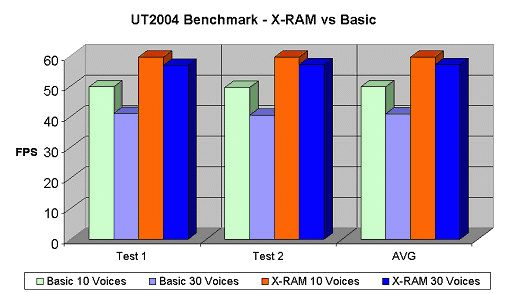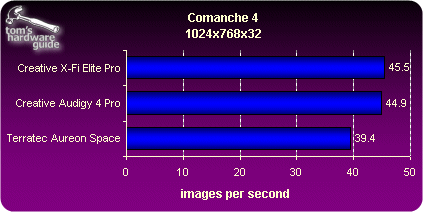Creative X-Fi: A New World of Sound
Games And 3D, Continued
For its cards specifically aimed at "hard gamers" - the Fatal1ty FPS and Elite Pro - Creative has chosen to use a type of memory called X-RAM. This dedicated memory avoids drawing on the computer's main memory and also avoids compressing sounds to store them in memory. The technology makes it possible either to add effects without suffering a performance hit, or to increase performance by using compressed sounds, with decompression taking place upstream of the game action. Creative has run tests with a modified version of Unreal Tournament 2004 . The graph below (source: Creative) gives you an idea of the effectiveness of X-RAM, which increases with the number of voices used.

Naturally, this demonstration remains fairly theoretical for the moment; we'll have to wait to see what game developers will do with this new technology. We'll report back to you when the first optimized games become available.
Tests we made with our usual games showed results that are comparable to those we got with the most recent Audigy cards (Audigy 2 ZS and Audigy 4). Naturally the sound quality was better, particularly for headphone listening, but the gain in CPU resources wasn't very significant. To make sure, we compared an Audigy 2 ZS to an X-Fi in Battlefield 2 , which is already optimized, and Doom 3 , for which Creative supplied us with a patch.
We ran the tests on a high-end PC (AMD Athlon FX51 processor, 1 GB of DDR at 400 MHz, ATI X800 XTPE 3D card). At best, we noted an improvement of 1 to 2 frames per second in Battlefield 2 (1280x960, maximum detail, high-quality sound, EAX effects enabled), and only in certain phases of the game at certain times. In Doom 3 (1024x768, maximum detail) the improvement was just as slight. We might mention in passing that the quality of the effects didn't seem very different between the normal and optimized versions. On the other hand, with no loss of performance, you get the benefit of the Crystalizer, CMSS 3D, and surround sound with a headset - which is not bad for a start. Sound has to be programmed in Open AL to get the full benefit of the X-Fi, and optimization of programming and of the drivers for the card is only in its early stages. Again, we'll be keeping up with the latest developments for you...


The processor-use test with Direct 3D produced remarkable results, with less than 3.5% utilization of the CPU.

In actual use with current games, and compared to an Audigy 2, don't expect to gain a lot of frames per second or a more spectacular 5.1 sound environment. If your speakers are good, the sound will be noticeably better, but it won't blow you off your stool. On the other hand, if you use headphones, the difference is like night and day. In fact, you may even want to consider always using headphones from now on. The sensation of immersion in the game is even better than with a well-placed 5.1 speaker kit. You get the benefit of the immersive qualities of headphones, without losing the notion of spatiality you get with speakers. Until optimized games become available, this is the real advantage of X-Fi as far as gaming is concerned.
Stay on the Cutting Edge
Join the experts who read Tom's Hardware for the inside track on enthusiast PC tech news — and have for over 25 years. We'll send breaking news and in-depth reviews of CPUs, GPUs, AI, maker hardware and more straight to your inbox.
Most Popular

